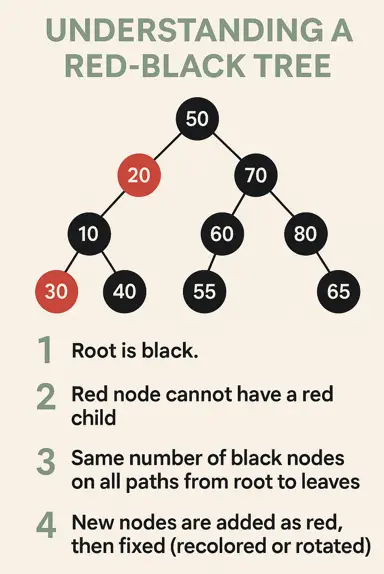Red-Black Tree Explained: Java TreeMap & BST Guide (2025)

1️⃣ Introduction
A Red-Black Tree is a self-balancing binary search tree (BST) that guarantees O(log n) time for search, insert, and delete operations. It is the underlying data structure for Java's TreeMap and TreeSet.
2️⃣ Binary Search Tree (BST) Foundation
A Binary Search Tree is a tree data structure where each node has at most two children, and for every node:
- All nodes in the left subtree have values less than the node's value.
- All nodes in the right subtree have values greater than the node's value.
BSTs allow fast lookup, insertion, and deletion, but can become unbalanced, leading to poor performance (O(n) in the worst case).
// Simple BST Node in Java
class Node {
int value;
Node left, right;
Node(int value) {
this.value = value;
}
}
3️⃣ What is a Red-Black Tree?
A Red-Black Tree is a special kind of BST with extra properties to ensure the tree remains balanced:
- Each node is either red or black.
- The root is always black.
- All leaves (null nodes) are black.
- If a node is red, both its children are black (no two reds in a row).
- Every path from a node to its descendant leaves contains the same number of black nodes.
These properties guarantee that the longest path from the root to a leaf is no more than twice as long as the shortest path, ensuring O(log n) operations.
// Red-Black Tree Node (conceptual)
class RBNode {
int value;
RBNode left, right;
boolean isRed;
RBNode(int value) {
this.value = value;
this.isRed = true; // new nodes are red by default
}
}
4️⃣ Red-Black Tree Operations
- Insertion: Insert as in BST, then fix violations by recoloring and rotations.
- Deletion: Remove as in BST, then fix violations to maintain properties.
- Balancing: Achieved through color flips and tree rotations (left/right).
Pro Tip: Red-Black Trees are more efficient for frequent insertions and deletions compared to AVL trees, which are stricter in balancing.
5️⃣ Red-Black Tree in Java: TreeMap
Java's TreeMap and TreeSet use a Red-Black Tree under the hood. This ensures that all operations (get, put, remove, etc.) are O(log n).
// Example: Using TreeMap in Java
import java.util.TreeMap;
public class RBTreeMapDemo {
public static void main(String[] args) {
TreeMap map = new TreeMap<>();
map.put(10, "Ten");
map.put(20, "Twenty");
map.put(15, "Fifteen");
System.out.println(map);
}
}
Note: TreeMap maintains keys in sorted order and provides efficient range queries.
6️⃣ Best Practices & Pro Tips 🚀
- Use
TreeMapwhen you need sorted keys and efficient range queries. - For frequent insertions/deletions, Red-Black Trees offer good performance guarantees.
- Understand the difference between
HashMap(O(1) average) andTreeMap(O(log n)). - Don't implement your own Red-Black Tree unless necessary—use Java's built-in collections.
7️⃣ Frequently Asked Questions (FAQ)
Collections.synchronizedSortedMap or external synchronization for thread safety.
Read Next 📖
Conclusion
Red-Black Trees are a foundational data structure for efficient, balanced maps and sets in Java. Understanding their properties and how TreeMap uses them will help you write more efficient and reliable code.